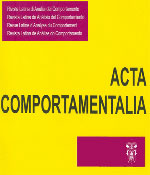Description of the task and imitative behavior
Main Article Content
Abstract
To describe the model´s behavior is one of the variables that have been proposed to enhance or make difficult imitative behavior. Variability has been common in studies with different conceptual standpoints to explain results. Two studies were conducted to functionally analyse the role of role of descriptions according to the conditions in which they were implemented. The fist study was conducted to evaluate four types of descriptions along five tasks in 48-delay imitative condition: the observer ´s exponsure to model´s behavior and to description of model´s behavior, the observer´s description of the model´s behavior, the observer´s condition. The level of imitative behavior was reduced showing a certain level of consistency along tasks and subjects with a very poor descriptive behavior of the model´s behavior which prevented the analysis of this variable. A second study increased the correct descriptive performance of the model´s behavior until 90% obtained by providing three opportunities to watch the model´s behaving after giving feedback of the model´s sequence in which description was not correct. Comparisons were obtained among this condition, a control condition with three opportunities to watch the model´s behavior, and the previous conditions with incorrect description. All subjects along the five tasks showed a high level of imitative behavior. Results are discussed in terms of the type of rule-governed behavior involved in the imitative experimental condtions, the probable history with each task and the experimental conditions providing a more or less discriminative function to the relevant components to imitate.
Article Details
Citas en Dimensions Service

<a rel="license" href="http://creativecommons.org/licenses/by-nc-sa/4.0/"><img alt="Licencia de Creative Commons" style="border-width:0" src="https://i.creativecommons.org/l/by-nc-sa/4.0/88x31.png" /></a><br />Este obra está bajo una <a rel="license" href="http://creativecommons.org/licenses/by-nc-sa/4.0/">licencia de Creative Commons Reconocimiento-NoComercial-CompartirIgual 4.0 Internacional</a>.
